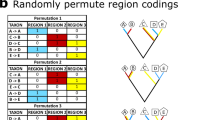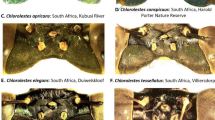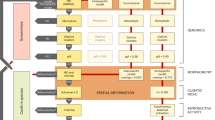Abstract
The close correspondence often observed between the taxonomy of parasites and their hosts1,2 has led to Fahrenholz's rule3, which postulates that parasites and their hosts speciate in synchrony. This leads to the prediction that phylogenetic trees of parasites and their hosts should be topologically identical2,4. We report here a test of this prediction which involves the construction of phylogenetic trees for rodents and their ectoparasites using protein electrophoretic data. We find a high degree of concordance in the branching patterns of the trees which suggests that there is a history of cospeciation in this host–parasite assemblage. In several cases where the branching patterns were identical in the host and parasite phylogenies, the branch lengths were also very similar which, given the assumptions of molecular clock theory, strongly suggests that the speciation of these hosts and ectoparasites was roughly contemporaneous and causally related.
This is a preview of subscription content, access via your institution
Access options
Subscribe to this journal
Receive 51 print issues and online access
$199.00 per year
only $3.90 per issue
Buy this article
- Purchase on SpringerLink
- Instant access to full article PDF
Prices may be subject to local taxes which are calculated during checkout
Similar content being viewed by others
References
Mitter, C. & Brooks, D. R. in Coevolution (eds Futuyma, D. J. & Slatkin, M.) 65–98 (Sinauer, Sunderland, Massachusetts, 1983).
Stone, A. R. & Hawksworth, D. L. Coevolution and Systematics (Clarendon, Oxford, 1986).
Eichler, W. Annls mag. nat. Hist. 12, 588–598 (1948).
Lyal, C. H. C. J. nat. Hist. 21, 1–28 (1987).
Marshall, A. G. The Ecology of Ectoparasitic Insects (Academic, London, 1981).
Smolen, M. J., Genoways, H. H. & Baker, R. J. J. Mammal 61, 224–236 (1980).
Timm, R. M. in Coevolution (ed. Nitecki, M. H.) 225–265 (University of Chicago Press, 1983).
Harris, H. & Hopkinson, D. A. Handbook of Enzyme Electrophoresis in Human Genetics (North-Holland, Amsterdam, 1976).
Hafner, M. S., Hafner, J. C., Patton, J. L. & Smith, M. F. Syst. Zool. 36, 18–34 (1987).
Honeycutt, R. L. & Williams, S. L. J. Mammal 63, 208–217 (1982).
Sneath, P. H. A. & Sokal, R. R. Numerical Taxonomy (Freeman, San Francisco, 1973).
Nelson, G. & Platnick, N. Systematics and Biogeography (Columbia University Press, 1981).
Hall, E. R. The Mammals of North America (Wiley, New York, 1981).
Wilson, A. C., Carlson, S. S. & White, T. J. A. Rev. Biochem. 46, 573–639 (1977).
King, J. L. & Jukes, T. H. Science 164, 788–798 (1969).
Fitch, W. M. in Molecular Evolution (ed. Ayala, F. J.) 160–178 (Sinauer, Sunderland, Massachusetts, 1976).
Sarich, V. M. Nature 265, 24–28 (1977).
Kojima, K., Gillespie, J. H. & Tobari, Y. N. Biochem. Genet. 4, 627–637 (1970).
Rogers, J. S. Univ. Texas Publ. 7213, 145–153 (1972).
Author information
Authors and Affiliations
Rights and permissions
About this article
Cite this article
Hafner, M., Nadler, S. Phylogenetic trees support the coevolution of parasites and their hosts. Nature 332, 258–259 (1988). https://doi.org/10.1038/332258a0
Received:
Accepted:
Issue Date:
DOI: https://doi.org/10.1038/332258a0



